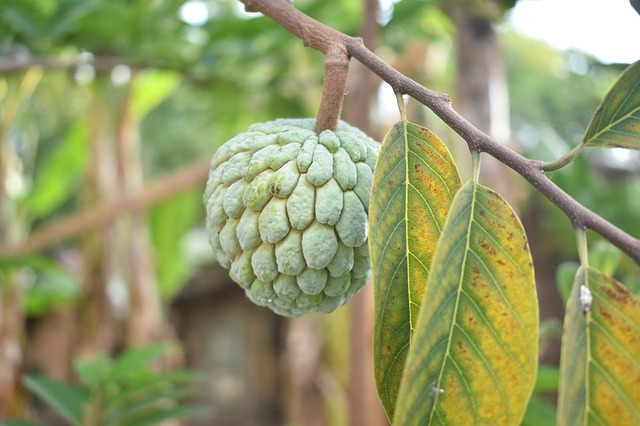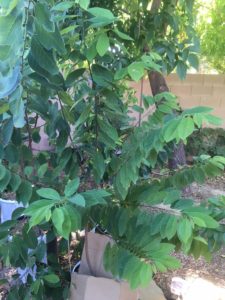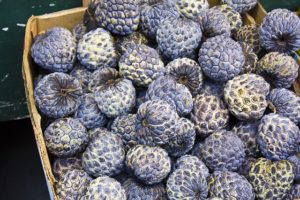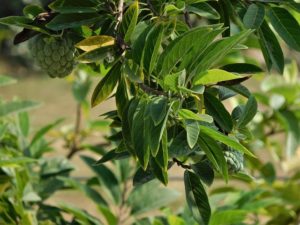Growing Sugar Apple in Hot, Dry Climates

I am currently growing several different Annona species in my backyard in the Arizona desert. These trees are mostly experimental in our climate, since they typically require a good amount of humidity to set fruit. Let’s take a look at growing sugar apple in hot dry climates.
Sugar Apple tends to adapt pretty well to hot, dry climates. I think Sugar Apple is one of the easier Annona’s to grow and fruit in a hot, dry climate like the desert.I was able to try a frozen Sugar Apple and enjoyed the taste, but was even more fortunate to find some fresh Sugar Apples in a local ethnic market.
I really loved the flavor and ended up saving some of the seeds. In my opinion the taste is similar to a cross between a strawberry and pineapple.
The fruit is creamy, but contains a lot of inedible black seeds.
Since Annona’s are marginal in my climate, see my post here on growing Soursop in hot, dry climates, I decided to grow all my Annona’s from seed.
As discussed in my post about growing Soursop, I would rather wait a little bit longer to grow from seed, than spend a lot of money on purchasing a tree that may never fruit.
I used the wet paper towel method to germinate the seed, which is basically moistening a paper towel, wrapping the seed in the moist paper towel, and placing it in a Ziploc bag.
After 3-4 weeks a few seeds germinated. Once the seed was large enough, I transplanted it into a container outdoors.
The tree has grown pretty vigorously in a little over a year and is around 6 feet tall. Sugar Apple trees are often grown from seed and produce quality fruit from seed grown trees.
You can also find more named grafted varieties. One thing I like about growing trees from seed in my climate is that it seems like seed grown trees handle our elements better since they grow more vigorous than a grafted tree.
I also have a seedling planted in the ground in mostly shade and it has grown a lot slower. I believe it is because of the lack of sunlight
It did get through some nights that dipped down to 28 degrees Fahrenheit without protection. Since it is located under the canopy of large trees it provides a shelter from frost.

Fruiting
Sugar Apples look similar to other Annona’s like Atemoya and Cherimoya, but is distinct in that it is segmented.
The texture of the fruit is very creamy and sweet. The flowers require hand pollination in our climate as it takes a special kind of insect to pollinate the flowers.
The flowers change from female to male in about 24 hours. Generally they are able to be pollinated in the female stage in the early morning.
You can collect the pollen from any male flowers in a small cup and use a paint brush or pipe cleaner to spread the pollen when the flowers are in the female stage.
I had a few flowers a year after growing the tree from seed, but decided to let the tree grow more before trying to get it to fruit. Sugar Apple trees flower in Spring time in the Arizona desert.
Gardening Skill Level
I would say that growing Sugar Apple in a hot, dry climate takes a moderate skill level.
Sugar Apples need a good microclimate that provides some afternoon shade in our extreme heat. I have mine in sun until about noon in the hot months and it seems to like that.
In the cooler months, it needs to be protected from frosts. I bring my Sugar Apple indoors when temps go below 35 degrees Fahrenheit.

Suitable for Container Growing
Sugar Apple trees do very well growing in a container. Sugar Apples seem to have a shallow root system and just tend to be smaller trees.
The fruits aren’t extremely large and heavy like some fruits. As always, slowly step the tree up to the next largest size pot and ensure it has good drainage.
Planting Tips
Sugar Apple trees don’t seem too finicky when it comes to soil requirements. As long as you have good drainage and isn’t in standing water, than you should be fine.
Ensure that you have the right microclimate to protect it from any potential frost if planting in the ground in subtropical regions.
Sugar Apple can do well as a companion tree since it doesn’t get very large and can be protected by another tree.
Watering
I give my Sugar Apple tree a steady dose of water in the hot months.
It doesn’t seem like it needs to stay extremely moist and can tolerate a slightly drier soil, but it is still a tropical fruit tree, and not a drought tolerant tree.
I keep it more on the dry side during cooler months to prevent root rot.
Feeding
I feed my Sugar Apple trees the same regimen as most of my tropical fruit trees. I give them a steady dose of liquid fish and seaweed fertilizer throughout the growing season.
I also periodically top with compost. I don’t notice any nutrient deficiencies with my Sugar Apple Tree.
Sun Exposure
I wouldn’t recommend planting a Sugar Apple in full all day sun in a desert climate. It’s best to give it some afternoon shade in the summer months when temps are consistently triple digits.
With that being said a Sugar Apple can handle a good amount of sun. I have another seedling that I planted in the ground in almost full shade.
It’s half the size of my container grown Sugar Apple that gets more sun.

Potential Problems
I sometimes scrape off mealy bug and occasionally find stink bugs on my Sugar Apple.
It seems that mealy bug is really attracted to the undersides of the larger leafed Annonas. So it helps to be routinely checking the leaves.
The Sugar Apple tends to cycle it’s leaves in late winter, so don’t be too alarmed if it starts to lose it’s leaves just before it starts putting out it’s new spring growth.


Thanks Joe for this straight to the point informative guide. I recently bought one Sugar Apple plant and this helped me out a lot.
Awesome, How is it doing? Are you in AZ?